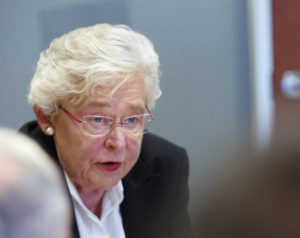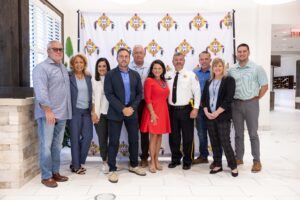Mobile principal wins discrimination lawsuit after being overlooked for job because of race
William Henderson won an employment discrimination lawsuit recently against Mobile county. According to Henderson’s attorney, John Goldfarb, this kind of case is very difficult to prove. “I don’t know what the statistics are of winning these cases in Mobile. I can’t remember when the last one happened,” he said. William Henderson is a 30-year employee for Mobile county schools. According to AL.com, Henderson had worked as a teacher, track and field coach, guidance counselor, achievement specialist, and assessment team leader in addition to being an assistant principal. According to his LinkedIn account, Henderson graduated from the University of South Alabama with his Bachelor’s degree in Secondary Education and teaching, his master’s degree in guidance counseling, and a certification in Education administration. He also graduated from the University of West Alabama as an Education Specialist in Instructional Leadership. He was an assistant principal when he tried to apply for a Principal position at Theodore High School, a predominately white school. Henderson did not get the job, even though the interview committee ranked Henderson as the top applicant. Instead, he received a principal position at a predominately Black school, where his pay was lower. According to the complaint, the school district used a scoring system to rank the candidates. Martha Peek, superintendent at the time, conducted her own interviews with candidates and scored a white candidate higher. Henderson’s lawyer argued to the jury that Peek created a score sheet that she presented to the school board as coming from the interview committee. “They really got caught red-handed with this fake score sheet that they couldn’t explain,” Goldfarb said. “She tried to deny it, but we could show it came from the superintendent’s office because it has the superintendent’s stamp on it.” The mostly white jury ruled in favor of Henderson. The jury awarded him $128,573.39 in back pay and damages. “The jury found he was being discriminated against because he was denied the principal(ship) of Theodore, which is traditionally a mostly white school, and they put him over an African American school,” said Goldfarb. According to school rankings at USNews.com, John Leflore Prep Academy is ranked 202nd in Alabama. Theodore High School is ranked 237th.
Federal grants to aid energy efficiency in Alabama

Nearly $370,000 in federal money is going to help improve energy efficiency at nearly 20 locations around Alabama. The grants announced Friday by Gov. Kay Ivey’s office are from the Energy Department. The aim is cut expenses for local governments, public schools and nonprofits. Schools in Cherokee and Colbert counties and the city of Huntsville are getting money for lighting upgrades, and Cleburne County will receive grant money for its courthouse and jail. The south Alabama town of Luverne will use grant money for lighting along streets and improvements at a wastewater treatment plant. Two churches in Mobile and Perry County will receive grants for lighting improvements. In all, $367,050 was awarded in 18 grants. Republished with the permission of the Associated Press.
Understanding Mobile County local amendment 1: pay-as-you-go infrastructure improvements

When Alabamians get to the polls on Tuesday, Nov. 6, voters in some counties will see local amendments on the ballot. Here’s a look at what residents of Mobile County need to know about a local amendment they’ll see on the ballot: On the ballot: Shall Mobile County in the State of Alabama be authorized to issue from time to time and in one or more series its Pay-As-You-Go Road, Bridge and Drainage Facilities Bonds, not exceeding $60,000,000 in principal amount, for the purpose of raising funds for the construction and improvement, or either, of hard surfaced roads, hard surfaced bridges, and surface water drainage facilities, or any thereof in the county, which bonds shall bear interest at a rate or rates to be fixed when they are sold, not exceeding twelve percent (12%) per annum, payable semiannually until their respective maturities, and shall mature and become payable on December 1 in the aggregate principal amount of $6,000,000 in each of the years 2022 through 2031, and shall the said county be authorized to continue to levy annually a special tax, on all taxable property in the county, at a rate not exceeding six and one-half mills on each dollar of the assessed valuation of such property, for the purpose of paying at their respective maturities the principal of and interest on the said bonds and all other bonds at any time outstanding which may be payable out of or constitute a charge on the said special tax, all pursuant to the provisions of Amendment 18, as amended and modified, to the Constitution of Alabama? Vote: For/Against said proposed Mobile County Pay-As-You-Go Road, Bridge and Drainage Facilities bonds and the said proposed continued levy of the said special tax What it means: If passed, the amendment will allow Pay-As-You-Go work to be completed within the City of Mobile including the : Improvement of Zeigler Blvd. to allow traffic to increase to 20,000 daily moving from the rural and suburban parts of Mobile into the downtown area. Widening of McGregor Ave. and constructing a new roundabout at Dauphin St. Resurfacing Airport Blvd. from McGregor Ave. eastward to Western American Circle Resurfacing of Hillcrest Rd. from Cottage Hill Rd. northward to Grelot Rd. In the county area, projects include: Extending the widening of Zeigler Blvd. from Schillinger Rd. to Tanner Williams Rd. Widening McDonald Rd. from I-10 to Old Pascagoula Rd. Building a new road to connect McDonald Rd. at Old Pascagoula Rd. to McFarland Rd. at Three Notch-Kroner Rd. This new road will allow traffic traveling down Snow Rd. and McFarland Rd. to have direct access to I-10. Resurfacing Three Notch-Kroner Rd. from Dawes Rd. to McDonald Rd. Resurfacing Padgett Switch Rd. from Half Mile Rd. to Hwy. 90. In total 67.9 miles would be added or improved. Sample ballot Click out the Mobile County sample ballot: Front side | Back side Don’t live in Mobile County? Find your county’s sample ballot here.
Mobile County teacher receives nation’s highest teaching honor at White House

A Mobile County science teacher received the nation’s highest teaching honor at White House ceremony on Wednesday. Chasity Collier, who teaches at Dawes Intermediate in Mobile, was presented the Presidential Award for Excellence in Mathematics and Science teaching. She also received a signed citation from President Donald Trump along a $10,000 grant from the National Science Foundation. “So humbled and honored to represent Alabama as the Presidential Awardees for Excellence in Science and Math Teachers @AlabamaDeptofEd @MobilePublicSch @HES_hsimpson #Nsf #PAEMST,” Collier tweeted Tuesday ahead of Wednesday’s award ceremony. Collier isn’t a stranger to the teaching limelight. She was Alabama Teacher of the Year for 2017-2018. She was among 104 recipients of the coveted award this year. “We are very proud of Mrs. Collier as she represents the wonderful teachers of Mobile County Public Schools and the fantastic teaching that takes place in our classrooms every day,” school system spokeswoman Rena Philips said. “She makes science come alive in her classroom every day, and her students love her and love science as a result.”
Jefferson, Mobile and Montgomery among 2 percent of counties that make up 51 percent of U.S murders

According to data from the Crime Prevention Research Center, 2 percent of counties in the nation make up 52 percent of murders throughout the nation. Alabama has three counties that make up part of that two percent; Jefferson, Mobile, and Montgomery. The state also had the third highest murder rate in the nation in 2016 with 407 murders out of a 4.8 million people population, giving the sate an 8.4 murder rate. According to the Alabama Law Enforcement Agency’s crime in Alabama report: In 2016 Jefferson county endured a total of 104 homicides, 78 of those taking place within the Birmingham city limits. The homicide rate was 15.69 per 100,000 people, and to put that in perspective, the national homicide rate was 5.3 per 100,000 people in 2016. Mobile county experienced a total of 61 homicides in 2016, 44 took place within Mobile city limits, and the homicide rate was 14.71 per 100,000 people. Montgomery county had the lowest number of the three, with only 31 total homicides, 30 taking place within Montgomery city limits. The county’s homicide rate was 13.76 per 100,000 people. According to the Crime Prevention Research Center: In 2014, the most recent year that a county level breakdown is available, 54 percent of counties (with 11 percent of the population) have no murders. 69 percent of counties have no more than one murder, and about 20 percent of the population. These counties account for only 4 percent of all murders in the country. The worst 1 percent of counties have 19 percent of the population and 37 percent of the murders. The worst 5 percent of counties contain 45 percent of the population and account for 68 percent of murders. As shown in figure 2, over half of murders occurred in only 2 percent of counties.” Murders actually used to be even more concentrated. From 1977 to 2000, on average 73 percent of counties in any give year had zero murders. Location is not the only factor in the concentration of murders; according to a 2013 PEW Research Center survey, gun ownership rates in rural areas were 2.11 times higher than in urban areas. In short, suburban households are 28.6 percent more likely to own guns than urban households. Most of the country has both very high gun ownership rates and zero murders. According to the data, murder isn’t a nationwide problem; and few people appreciate the large areas of the country where there are no murders. Researchers say that the problem lies within a very small set of urban areas, and the gun ownership, or lack of legal gun ownership, within those areas. To solve the problem, the Crime Prevention Research Center suggests focusing on the areas where murders are most common and doing what is necessary to reduce the amount of murders in that area. Here is the map detailing the counties in U.S. with highest murder rates:
Prichard mayor claims Alabama Gulf Coast Recovery Council failed to consider his city

The Alabama Gulf Coast Recovery Council — tasked with distributing funds earned from the civil penalties paid by companies involved in the 2010 Deepwater Horizon oil spill — made recommendations last week to fund more than 40 improvement projects to the region. Totaling $315 million (which includes $118 million for projects in Baldwin County and $161 for projects in Mobile County), the projects are mostly economic or environmental in nature. But not everyone who hoped to get funding for a project got it. Prichard Mayor Jimmie Gardner voiced his dismay over his city being left out of the funding projects during a news conference on Monday. “I understand that the City of Mobile is the hub of this area,” Gardner said during the news conference. “I support that, but if we don’t start funding these other cities who may not have the budget that a city like Mobile may have, you’re just a part of a problem in allowing these cities to deteriorate. Help them do better.” Prichard had hoped money to receive funds for drainage and sewer infrastructure improvements on West Turner Road and Lovejoy Loop. “As in most of our counties in Alabama, the infrastructure underneath the ground is poor. The city of Prichard has very old pipes which causes for the flooding. The BP restore act money was for drainage to be corrected on West Turner Road and Lovejoy Loop,” the city Tweeted. As in most of our counties in Alabama, the infrastructure underneath the ground is poor. The city of Prichard has very old pipes which causes for the flooding. The BP restore act money was for drainage to be corrected on West Turner Road and Lovejoy Loop. https://t.co/oqhdEBJiXx — The City of Prichard (@PrichardPride) March 10, 2018 Gardner also criticized the fact his Mobile-County city was not represented on the 10-member council — which includes Baldwin County Commissioner Frank Burt, Dauphin Island Mayor Jeff Collier, Bayou La Batre Mayor Terry Downey, Gulf Shores Mayor Robert Craft, Orange Beach Mayor Tony Kennon, Fairhope Mayor Karin Wilson, Mobile Mayor Sandy Stimpson, Mobile County Commission President Merceria Ludgood, Alabama State Port Authority Executive Director Jimmy Lyons and former U.S. Rep. Jo Bonner, who is serving as a liaison to Gov. Kay Ivey — that selected the projects. “We got to look at a better way to make sure that everyone has a fair opportunity, beyond someone else suggesting ‘my project is better than your project,’” Gardner added. He is now asking its residents to make use of the public comment period to request funding for Prichard. “Everyone please remember there is a 45-day public comment period. The city of Prichard and a couple of other municipalities did not receive any BP Restore funds. I believe there was a slight disparity in the allocation of the funds + heaviness towards Baldwin and mobile counties,” Tweeted the city person Gardner’s request. Everyone please remember there is a 45-day public comment period. The city of Prichard and a couple of other municipalities did not receive any BP Restore funds. I believe there was a slight disparity in the allocation of the funds + heaviness towards Baldwin and mobile counties. https://t.co/YssnWdjyw1 — The City of Prichard (@PrichardPride) March 10, 2018
Mobile delegation opposes amendment to allow vote on minimum wage hike

The House Committee on Mobile County Legislation met Wednesday to discuss a slew of local legislation, including HB248 from Rep. Napoleon Bracy (D-Mobile). The constitutional amendment would allow Mobile citizens to vote on whether or not to raise the county’s minimum wage to $10.10 an hour. Bracy brought forth the bill in the form of a constitutional amendment in order to skirt around legislation passed earlier this session. HB174 from Rep. David Faulkner (R-Birmingham), also known as the Alabama Uniform Minimum Wage and Right to Work Act, was filed to thwart efforts by the Birmingham city council to gradually raise that city’s minimum wage to $10.10 an hour over three years. After being signed into law by Gov. Robert Bentley, the bill effectively bars in Alabama city or county from raising its minimum wage. If passed, the amendment would have been voted on by Mobile County voters in the upcoming November election. At the time of the committee’s vote Wednesday, eight committee members were present. The four representatives who voted against the bill, causing voting to end in a tie and causing the bill to gain an unfavorable report, were Reps. David Sessions (R-Mobile), Victor Gaston (R-Mobile), Margie Wilcox (R-Mobile) and Jack Williams (R-Mobile). The four Democrats on the committee voted in favor of the measure. Because of its failure to garner a favorable report in the committee hearing, the bill will not be heard by the full House of Representatives.
John Merrill lays out information on School Board runoff election

Alabama Secretary of State John Merrill released information Wednesday regarding an April 12 runoff election in Mobile County. The election is for the District 1 State School Board member and pits Republican incumbent Matthew Brown against newcomer Jackie Zeigler. In the March 1 election, neither candidate got enough votes to outright win the party’s nomination. Because Mobile Public Schools will be enjoying Spring Break the week of the runoff, many residents will likely be out of town. Because of that, Merrill has released instructions on how residents can obtain an absentee ballot and cast their votes. Voters can download an absentee ballot application through the Secretary of State’s website or request one in person at 205 Government St. in Mobile. The last day to request a ballot is April 7. Ballots returned by mail must be sent by April 11 and received by noon on Election Day. Absentee ballots submitted in person must be turned in by close of business April 11. For information, contact Merrill’s office at (334) 242-7200.
Trustees, BP announce $134m in proposed early restoration projects on BP oil spill anniversary
On Monday, the fifth anniversary of the Deepwater Horizon explosion that killed 11 workers and released of 3.19 million barrels of oil into the Gulf of Mexico, federal and state Trustees, along with BP officials, announced 10 projects poised to receive funding for early restoration efforts along the Gulf of Mexico. Totaling $134 million, the proposed projects include enhancing bird and turtle nesting and habitats, improving near-shore and reef habitats, increasing recreational use of federal lands, and restoring fish in the Gulf. Four of the projects in this fourth round of funding for the Early Restoration Plan are located in Alabama: Osprey restoration project in Mobile and Baldwin counties Aimed at improving osprey nesting success, the project would establish five osprey nesting platforms. Located and designed to meet regulatory requirements and maximize project success, each platform would also include a predator guard. Five general areas have been identified for the location of these platforms: the vicinities of Portersville Bay, Dauphin Island, Fort Morgan, the Little Lagoon area in Gulf Shores and in Gulf State Park. The estimated cost for this project is $45,000. Point aux Pins “living shoreline” in Mobile County This project would reduce shoreline erosion, promote colonization of marsh vegetation, and create habitat for oysters, shrimp, crabs, fish, and other marine animals in coastal Alabama. Structures designed to reduce wave energy would be placed parallel to the shore near Bayou la Batre, at Point aux Pins, adjacent to an existing living shoreline project. The estimated cost for this project is $2,300,000. Shell Belt and Coden Belt roads “living shoreline” in Mobile County Similar to the Point aux Pins Living Shoreline project, this project would also promote colonization of marsh vegetation and create habitat for oysters, shrimp, crabs, fish, and other marine animals in coastal Alabama by placing structures designed to reduce wave energy parallel to shore near Shell Belt and Coden Belt roads in south Mobile County. The estimated cost for this project is $8,050,000. Bon Secour National Wildlife Refuge Trail enhancement in Baldwin County Designed to address the lost recreational usage of Jeff Friend Trail at Bon Secour National Wildlife Refuge, the project would rebuild a rapidly aging boardwalk and gravel trail and improve access from the parking area. The estimated cost for this project is $545,110. Monday’s plan is only a draft for Phase IV Early Restoration Plan, which will be released later in order to give the public the opportunity to review and comment at public meetings. As reported by AL.com “if all 10 are accepted, they will be added to the 54 projects that have already been approved and funded with the initial $1 billion allocated by BP.” According to NOAA Gulf Spill Restoration, “Early restoration allows the Trustees to jump-start restoration using up to $1 billion BP has agreed to make available for projects jointly agreed to by BP and the Trustees. In return, BP’s liability is reduced.” The full list of proposed projects and more information about the restoration program can be found here.


